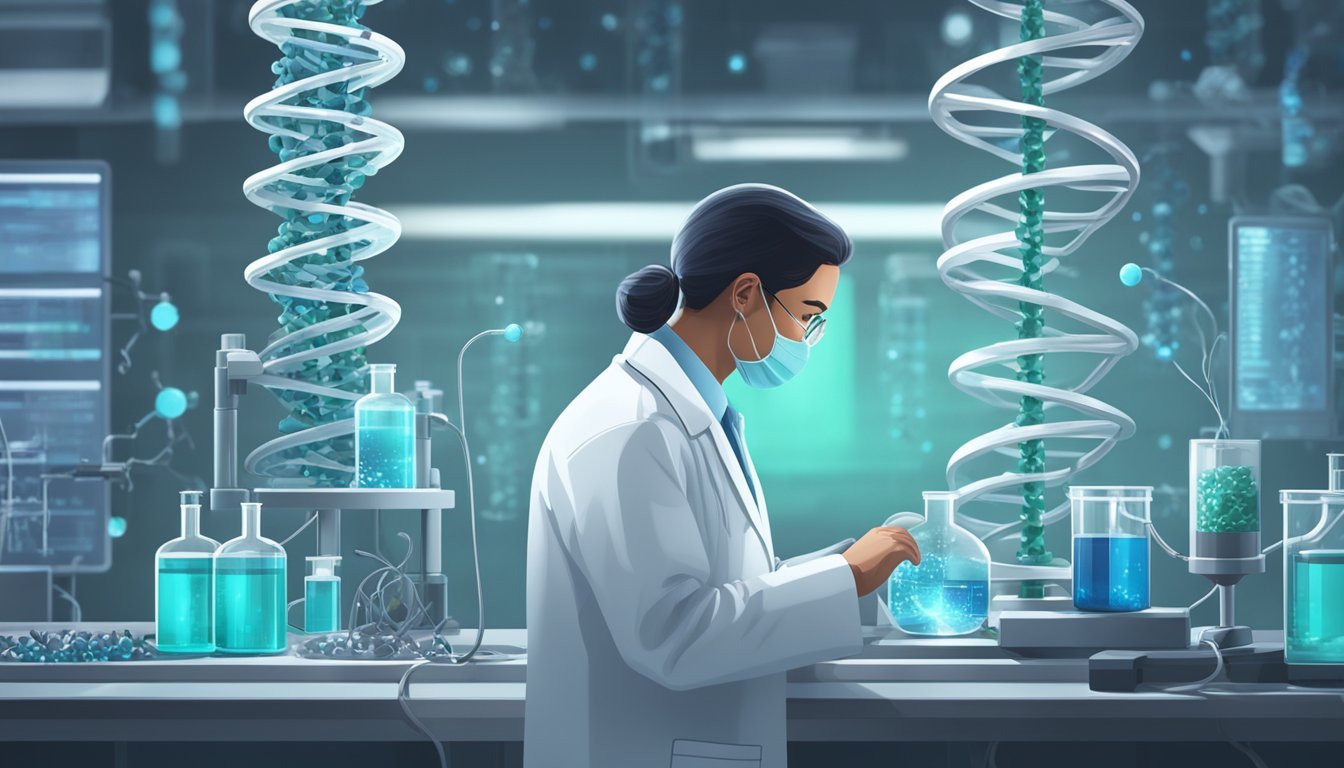Biohacking Your Body
Harnessing Biology for Personal Enhancement
Discover > Biohacking > Biohacking Your Body
Biohacking is changing our chemistry and physiology through science and self-experimentation to energize and enhance the human body. It's a broad definition that can encompass a variety of activities, from performing simple lifestyle modifications to implementing radical technological interventions. Proponents of biohacking see it as a means to optimize human potential by making the human body function more efficiently and potentially improving quality of life.
The concept often includes do-it-yourself biology, where individuals experiment on themselves to enhance physical and cognitive performance. Some common practices include dietary changes, adopting specific exercise routines, sleep management, and stress reduction techniques. More advanced biohacking may involve genetic editing technologies and implantable devices intersecting with the field of transhumanism.
Safety in biohacking is a primary concern, as the practice involves varying levels of invasiveness and risk. Beginners are cautioned to start small, using scientifically backed methods and proceeding carefully to monitor the effects on their health. Blood tests, tracking biomarkers, and consulting with healthcare professionals are prudent steps for those engaging in biohacking endeavors.
Fundamentals of Biohacking
Biohacking manipulates biology with a "do-it-yourself" mentality to enhance human abilities and well-being. It bridges gaps between science and daily living.
Understanding the Biohacking Movement
The biohacking movement has its roots in a combination of biology and hacker culture, emphasizing personal experimentation and applied biology. These self-experiments are not confined to just professional scientists' labs but extend into the everyday lives of those willing to push the boundaries of their own biology for optimal health and performance. Silicon Valley has played a pivotal role in popularizing biohacking, as many technologists began adopting and promoting methods to improve cognitive efficiency and overall health. Different subsets within biohacking include grinder biohacking, which involves implanting devices into the body to enhance physical abilities or senses.
Core Principles of Biohacking
Biohacking stands on several core principles that guide the majority of practices within this field:
Do-It-Yourself Biology: Individuals leverage scientific methods to perform self-directed biological experiments. This DIY biology approach often involves tracking and modifying one's diet, sleep patterns, and physical activities to fine-tune body functions.
Data-Driven Decisions: Using technology to monitor and analyze personal data is crucial. Biohackers collect data to make informed decisions about lifestyle modifications.
Incremental Changes: Most biohackers believe in making small, data-informed adjustments rather than drastic transformations. This iterative method helps identify what works best for the individual’s unique biology.
Optimizing Nutrition
Optimizing nutrition is a foundational aspect of biohacking. It involves tailoring dietary intake to enhance physical and cognitive functions through specific eating patterns, nutrient-rich foods, and supplements.
Intermittent Fasting and Fasting Techniques
Intermittent fasting is a biohacking technique that alternates between periods of eating and fasting. Some believe it can alleviate metabolic disorders and aid in weight loss. The Bulletproof Diet incorporates a form of intermittent fasting known as Bulletproof Coffee—coffee mixed with butter and coconut oil—to help curb appetite and provide sustained energy. Intermittent fasting can vary from the 16/8 method, where one fasts for 16 hours and eats during an 8-hour window, to longer fasts that may last up to 24 hours or more.
Essential Nutrients and Supplements
Vitamins and Minerals: A balanced diet rich in essential vitamins and minerals is crucial for optimal body function, these include vitamin D, A, C, E, K, and the B vitamins and minerals. Supplementation may be necessary for individuals with deficiencies.
Healthy Fats: Incorporate Omega-3 fatty acids from sources like wild fish to support brain health.
Nootropics and Nutrigenomics: The use of nootropics—substances that can enhance cognitive function—is a growing trend in biohacking nutrition. Combining these with understanding nutrigenomics, or how nutrition influences genes, can further personalize nutrition plans. Early evidence suggests nutrigenomics reveals brain gene networks linking metabolic and brain disorders.
Role of Diet in Biohacking
Biohacking through diet is more than just weight loss; it enhances performance and health. Selecting the right foods is pivotal:
Elimination Diet: By removing common allergens, the elimination diet stops the gut's reaction to gluten, dairy, and corn and also helps to identify potential food sensitivities. The thinking of the elimination diet is that once you stop consuming a food that you're sensitive to, the change in nutrients affect inflammation in your gut, and your immune system will calm giving better health.
Sugar and Caffeine: Moderating sugar intake and understanding the effects of caffeine are important for maintaining balanced energy levels and preventing crashes.
Hydration: Adequate water intake is vital for all biological processes, including nutrient absorption and elimination of toxins.
Enhancing Physical Health
In the domain of biohacking, enhancing physical health is of paramount concern. It improves blood pressure, muscle tone, and mood. Biohackers employ a range of tactics to fortify the body, augment energy levels, improve sleep quality, and fortify the immune system, aiming to transcend the limitations of traditional fitness and health paradigms.
Exercise and Fitness Regimens
Critical components of physical biohacking involve tailored exercise regimes designed to maximize energy usage and improve physical fitness, such as heart function, blood flow, blood pressure and bone health. High-Intensity Interval Training (HIIT) is a popular method in athletic performance known for its efficiency in improving cardiovascular fitness and potentially reducing blood pressure and chronic disease risk. Body-specific exercise programs can be augmented through regular blood testing to track markers like blood sugar and lipid profiles, ensuring that one's fitness routine aligns with personal health goals, body composition, body weight and provides precise feedback for further enhancements.
Wearable Technology and Tracking
Wearable technology, such as smartwatches and fitness trackers like Fitbit, has become essential in biohacking your health. These devices continuously gather data on heart rate, sleep patterns, and activity levels. With the help of these wearables, individuals can make data-driven decisions on their daily habits, track their fitness progress in real time, and adjust their routines to optimize sleep quality and energy levels.
Biohacking for Longevity
A contemporary approach to prolonging life involves biohacks aimed at enhancing longevity by reducing the risks associated with chronic diseases. Strategies like intermittent fasting, cold exposure through cold showers, and blood testing for biomarkers can aid in longevity biohacking by potentially strengthening the immune system and mitigating chronic inflammation. Biohackers prioritize monitoring health signals through blood tests, acknowledging that biohacking for longevity is about sustaining upgrades to one's lifestyle and health habits.
Improving Mental and Cognitive Function
Mental and cognitive function enhancement can be achieved through various methods, including biohacking supplements with nootropics, engagement in neurofeedback, and mindfulness and meditation. Each strategy offers distinct benefits, from improved memory and focus to stress reduction and bolstered mental performance.
Nootropics and Smart Drugs
Nootropics, commonly referred to as "smart drugs", are substances that may improve cognitive performance. These can be synthetic or natural and enhance healthy individuals' memory, creativity, and motivation. Omega-3 fatty acids and turmeric are two examples of natural nootropics noted for their potential to support brain health. Omega-3s are crucial for maintaining cell membrane health and are linked to reduced cognitive decline rates. Turmeric contains curcumin, known for its anti-inflammatory effects and ability to improve memory and mood potentially.
Neurofeedback and Cognitive Exercises
Neurofeedback is a form of biofeedback that uses real-time displays of brain activity—most commonly electroencephalography (EEG)—to teach self-regulation of brain functions. It can improve mental health and cognitive performance by targeting specific brainwave patterns. Cognitive exercises like puzzle-solving and memory games prompt the brain to form new connections, leading to enhanced focus and cognitive resilience.
Mindfulness and Meditation Practices
Mindfulness and meditation practices are powerful tools for reducing stress and enhancing cognitive function, including attention and memory. Regular meditation has been shown to alter the structure and function of the brain, leading to improved mental health and performance. Mindfulness, the quality of being present and fully engaged with whatever one is doing at the moment, can increase one's awareness and clarity in thinking.
Lifestyle and Wellness Approaches
In biohacking, the focus is on optimizing lifestyle choices to enhance well-being. Individuals may become more energized and productive through controlled modifications in sleep, rewilding, and stress management.
The Impact of Sleep on Well-Being
Quality sleep is foundational to feeling well. Optimizing sleep can improve mood, cognitive function, and overall health. Adult individuals typically require 7-9 hours of sleep per night. Adopting a consistent sleep schedule and creating an environment conducive to rest—like a dark, cool room—can significantly improve sleep quality.
Track sleep patterns
Limit exposure to blue light before bedtime.
Maintain a sleep-conducive environment
Lifestyle Changes and Rewilding
Rewilding refers to the practice of reconnecting with nature to revive health and spirit. It incorporates lifestyle changes that enhance an individual's connection with the natural environment. Activities can include outdoor exercises, cultivating a garden, or simply spending time in green spaces. The objective is to harmonize with nature, which, in turn, can lead to feeling more connected and alive.
Spend time outdoors daily.
Introduce plants into living and working spaces.
Engage in outdoor physical activity
Stress Management Techniques
Managing stress is crucial for maintaining mental and emotional wellness. Techniques such as mindfulness meditation, yoga, and deep-breathing exercises can help individuals gain control over their stress responses. Regular practice can make an individual feel more centered and less affected by daily stressors.
Practice mindfulness or meditation.
Incorporate regular physical activity.
Establish boundaries to avoid overcommitment
Advanced Biohacking Techniques
In biohacking, advanced techniques push the boundaries of science and personal enhancement. They involve cutting-edge technologies like CRISPR for gene editing, the use of stem cells for regeneration and healing, and the grassroots grinder movement for extreme body modification.
Genetic Engineering and CRISPR
CRISPR (Clustered Regularly Interspaced Short Palindromic Repeats) is a revolutionary biotechnology that enables precise genetic engineering. It allows scientists and biohackers to edit DNA sequences and modify gene function. It is a powerful tool for potential therapeutic applications, such as correcting genetic defects and preventing the spread of diseases. However, the use of CRISPR raises significant ethical concerns and is subject to strict regulations by the FDA to ensure safety and efficacy.
Stem Cell Therapies and Research
Stem cell therapies are at the forefront of regenerative medicine. These therapies utilize stem cells for their unique ability to develop into different cell types in the body, offering promise for repairing damaged tissues and organs. Such techniques are being researched for conditions ranging from spinal cord injuries to heart disease. The research is heavily science-based and often involves self-experimentation within the biohacking community. Despite its vast potential, stem cell research is tightly regulated to ensure ethical practices.
Grinder Movement and Extreme Biohacking
The Grinder movement represents the most extreme end of biohacking. Grinders are a community that engages in DIY body modifications to enhance their physical or cognitive capabilities. This can include the implantation of devices or tinkering with the body's own systems or body composition. The movement operates largely outside traditional legal and regulatory frameworks, which poses risks but also speaks to a culture of radical self-experimentation and a desire to push human limits. It clearly demonstrates where the bleeding edge of biotech meets the ethos of the hacking community.
Considerations and Ethics
Biohacking intersects with a range of ethical, safety, and legal considerations, highlighting the importance of responsibility when altering the body's natural processes. The dialogue around biohacking is dynamic, covering everything from smart drugs to genetic editing, all with the potential to affect overall health, mental health, and productivity.
Safety and Legal Issues
The safety of biohacking practices can vary widely, from relatively low-risk activities like fitness optimization to high-risk genetic modifications. The use of smart drugs and nootropics, for instance, may improve cognitive performance, but these substances can pose risks without proper prescription and oversight. Unregulated supplements, popularized by figures like Dave Asprey, may not be thoroughly tested, posing potential health risks.
In the legal realm, the FDA monitors and regulates medical treatments and interventions to ensure safety and efficacy. Biohackers, however, often operate in spaces not yet clearly defined by law. For example, Silicon Valley entrepreneurs may experiment with off-label use of medications to enhance productivity, invoking complex control issues regarding prescription use.
Biohacking and the Medical Community
While the medical community traditionally upholds principles such as beneficence and nonmaleficence, the biohacking movement often prioritizes individual autonomy and self-experimentation. The goals of enhanced fitness, health, and mental clarity are shared, but medical professionals caution against untested interventions lacking scientific support.
Biohackers may defend their methods as part of a personal quest for peak performance and control over one’s biology, thus challenging the traditional scope of science and nature. However, the medical community's concern is that without proper controls and understanding, there could be unintended and adverse effects on overall health.
Conclusion
Biohacking represents an innovative approach to personal wellness, where individuals take an active role in enhancing their own biology. It has drawn attention to its potential to improve health, performance, and well-being through a variety of methods, ranging from simple lifestyle changes and eating healthy foods to more advanced techniques like genetic engineering.
Personal Agency: Individuals are empowered to make data-driven decisions about their health, often using self-experimentation to determine what works best for their unique biology.
Safety Considerations: Those interested should proceed cautiously, prioritizing safety and scientific validity. Not all biohacks are created equal; some can pose significant risks if not approached responsibly.
Diversity of Approaches:
Dietary Modifications: Incremental changes like intermittent fasting or the inclusion of certain supplements.
Lifestyle Tweaks: Sleep optimization and stress management.
Technological Integration: Use wearables or even embeddable devices to monitor and enhance physiological functions.
The field continues to evolve rapidly, offering a range of options for those looking to optimize their health. Despite its potential, individuals must seek information and, when necessary, professional guidance to navigate the complexities of biohacking effectively and safely.




